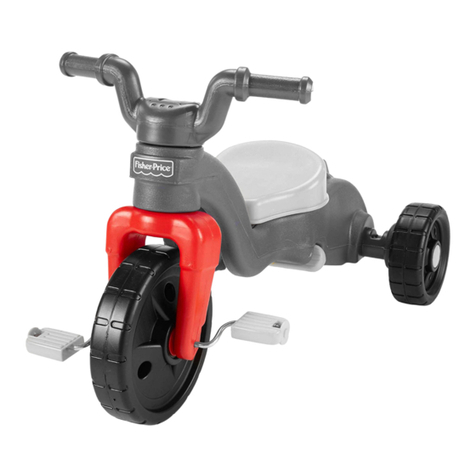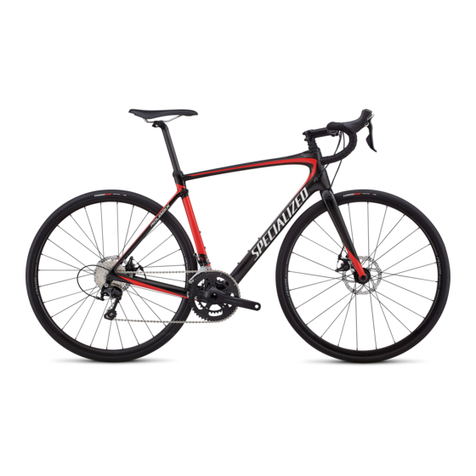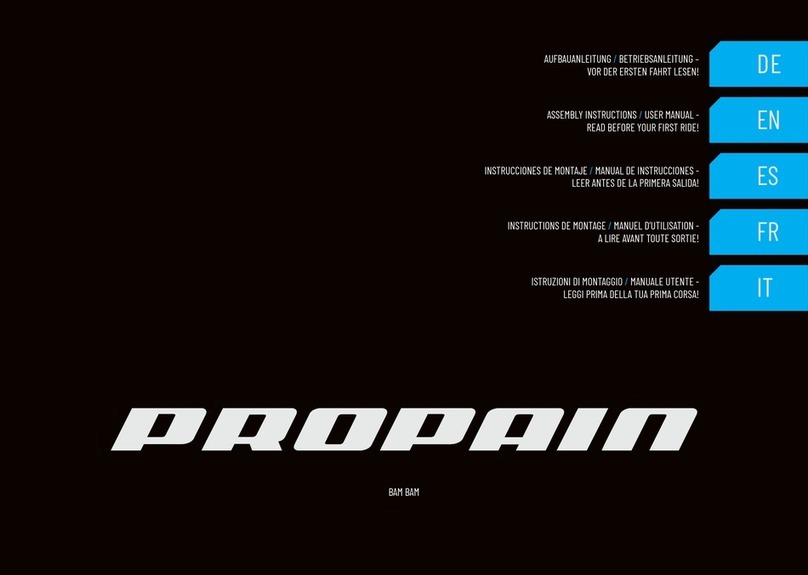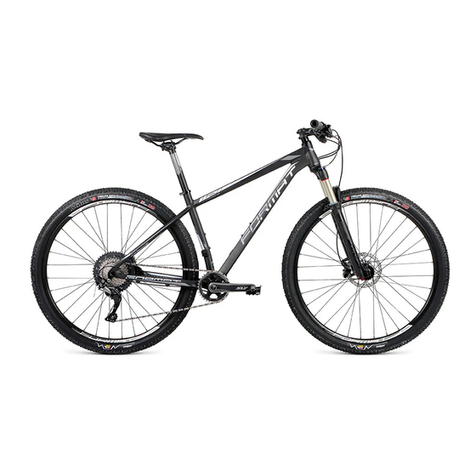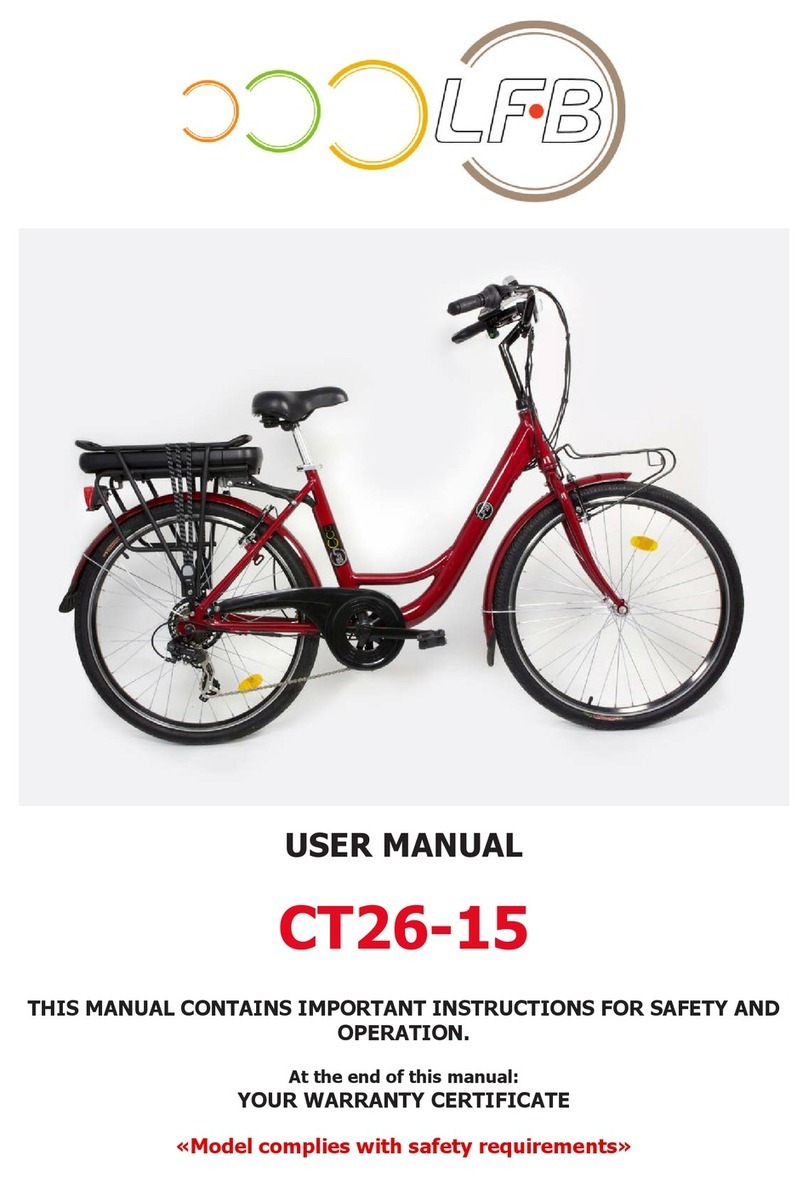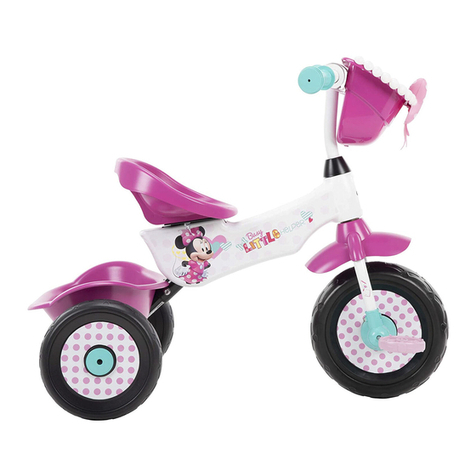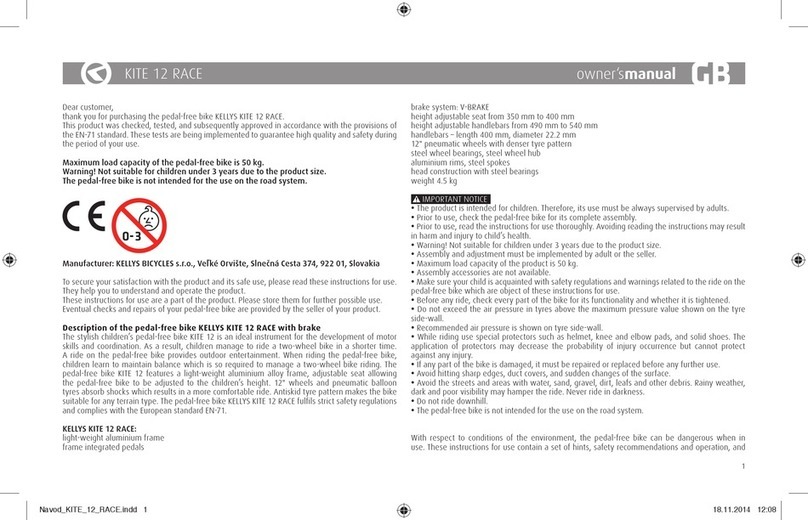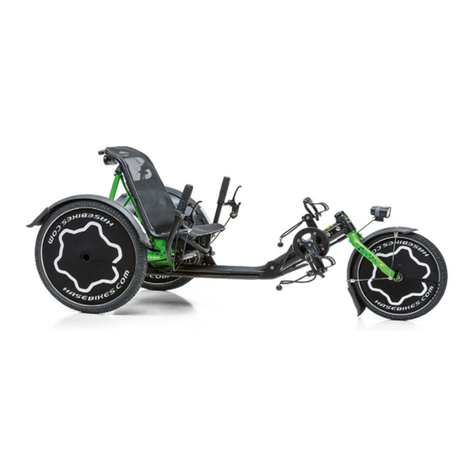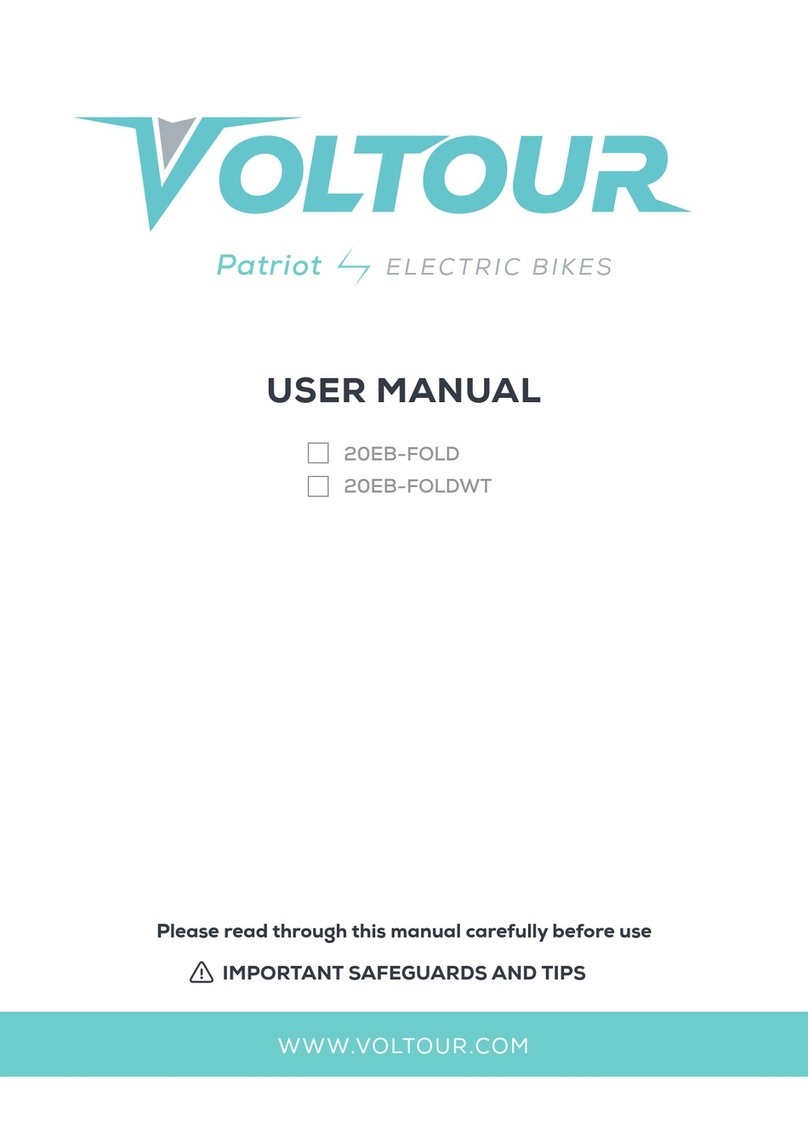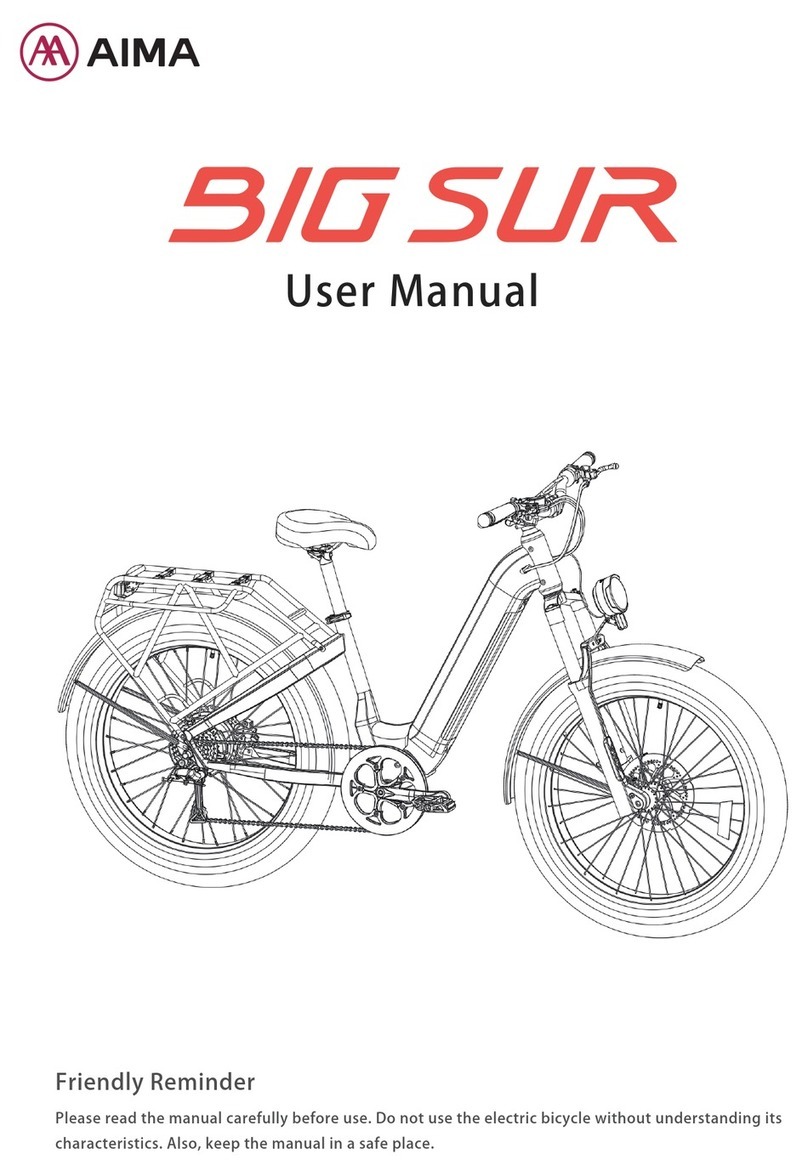BAYK BRING S User manual

1
in cooperation with
ORIGINAL-MANUAL
CARGOBIKE-HANDBOOK
EN

2
Dear customer,
Thank you very much for choosing a cargobike
from our company.
These operating instructions answer essential ques-
tions and give many tips for operating your vehicle.
Please also note the enclosed manual for the
initial operation of the cargobike, which con-
tains all the details for a successful start.
If you are unsure after reading this manual and
have any questions, please contact our customer
service directly: +49 9409 86 255 77
Your BAYK team

3
General information
Safety
Legal requirements
Intended use
Before the rst ride
Before every ride (short check)
Adjusting the riding position
Braking system
Gears
Drive chains
Wheels and tyres
Repairing a puncture
Lighting system
Duty transport
Drive system
Range in cold conditions
General care instructions
Inspections
Environmental tips
Statutory warranty / guarantee
Tightening torques for screwed connections
Service and maintenance plan
Important documents
4
5
6
8
9
12
13
14
15
16
18
20
21
22
23
26
28
29
INHALT
Loading, p. 18
Lighting system, S. 16
Gears, S. 13
Braking system, p. 12
Sitting position,
p. 9
Wheels and tyres, p. 15
Chains, p. 14
Lighting system, p. 16
Drive system, p. 18

4
This manual covers the installation and maintenance
work, which may be necessary between the prescribed
inspections to be carried out (see page 28). Do not
perform any task that you are uncomfortable with.
Many of these tasks require special knowledge and
tools and should only be performed by an expert.
Never ride your bike with incomplete or improper
maintenance. You could endanger your life or the lives
of others.
Before using your cargobike, you must read the enclo-
sed Quick Start Manual completely; be sure to observe
all safety instructions contained therein!
DANGER!
ACHTUNG!
If you have any questions, please contact a authorised service part-
ner.
We wish you much joy and success with your new BRING S cargobi-
ke.
Read all instructions in this manual carefully before your rst ride.
Please note the following symbols:
These symbols will be used from now on, without re-explaining their
meaning. For your own safety, make the short check before every
ride. He is described on page 8.
GENERAL INFORMATION
ATTENTION! Note that will help you to become familiar
with your cargobike and its technology quickly.
DANGER! Possible dangers for your life and your
health, if appropriate action calls are ignored.
TIP! Useful additional information.
Use torque spanner and comply with the specied
torques.

5
Note that the cargobike immediately moves, when you
start pedaling and the electrical assistance is switched
on. So rst pull the brakes and then get on the car-
gobike. Otherwise the unexpected move can lead to
accidents and hazards.
Shut o the electrical assistance and unplug the batte-
ries before you start to work on your cargobike. Unin-
tended activation of the e-drive can lead to injuries.
DANGER!
DANGER!
SAFETY
If you want to use your cargobike on public roads, it must be
equipped according to national regulations. Legally, it is equal to the
bicycle and therefore subject to the same regulations.
In Germany these are regulated in the Road Trac Licensing Re-
gulations (StVZO) and the Road Trac Act (STVO). In Switzerland,
the regulations in force in the regulations governing the technical
requirements for road vehicles are set out in Articles 213 to 218. To
participate in public road trac in Austria, you must comply with
the 146th Ordinance / Bicycle Ordinance. These can be found in the
Federal Law of Austria.
Before using your cargobike in a country other
than Germany, Austria or Switzerland, please inform
yourself about any legal peculiarities in the respective
country.
TIP!
LEGAL REQUIREMENTS
The BRING S vehicle is EC-conforming to the Machinery Directive
2006/42 / EC, Annex II A. The product complies with the provisions of
the above-mentioned directive - including the amendments valid at
the time of the declaration. The following national standard has been
applied: DIN EN 15194-2017

6
Your cargobike is basically intended for the trans-
portation of a single person only. Pay attention to the
maximum gross weight (see below).
DANGER!
Your cargobike is designed for use on roads and paved roads only.
You may therefore e.g. do not drive on stairs, do drops or similar
activities. Operating, maintenance and service conditions, which are
described in this operating manual, are part of the intended use.
No liability or warranty is accepted if the use of the vehicle goes
beyond its intended use, if safety instructions are not adhered to, if
overloading or defects are improperly removed. Likewise, no liability
and warranty will be accepted for assembly errors, intent, accidents
and if the requirements for maintenance and care are not met.
Changing the gear ratio and altering the electrical system (tuning) will
result in the loss of all warranty and warranty claims.
INTENDED USE
BEFORE THE FIRST RIDE
Permitted total weight = 330 kg =
Weight driver +
Weight Flexbox 49 kg +
Weight charge +
Weight load
Permitted total weight = 495 kg -
Unladen weight Pick-Up 160 kg -
Weight Flexbox 55 kg -
Weight driver 90 kg =
Payload 190 kg
TIP!
EXAMPLE:
Your new cargobike will be delivered ready to drive for
safe operation. The handover of the cargobike to you
must be documented in the cargobike vehicle registra-
tion document and in the ID document (see page 29).
Check the tightness of all important fastening screws
and nuts.
Check the air pressure in the tires. The information on
the prescribed tire pressure can be found on the side
surfaces of the tires. Comply with the minimum and
maximum pressure specications! Check tires and rims
for damage, cracks and deformation.
Check the tightness of the battery. Check the charge
status of the battery.
ATTENTION!

7
BRAKING SYSTEM
Familiarize yourself with the functions of all controls.
With activated cargobike drive, the cargobike imme-
diately moves, when you start pedaling! So pull the
brakes before getting on the cargobike. The unaccus-
tomed move may lead to hazards and accidents.
DANGER!
Details on brakes can be found on page 12.
GEARS
Motorcycle brakes work much harder than simple rim
or bicycle disc brakes! Be sure to test o the road rst.
Careless operation of the brakes can lead to a fall.
Slowly approach stronger deceleration.
At full load, the handling changes, especially when cor-
nering. The braking distance is longer. Therefore, at the
beginning, do some driving and braking tests with and
without payload in order to get used to the changed
driving behavior.
DANGER!
DANGER!
Familiarize yourself with the new gearhub in a safe place. More about
gear shifting on page 13.
If your cargobike is tted with pedals with rubber or
plastic cage, please become familiar with their grip.
Pedals with rubber or plastic cage may get slippery
when wet!
DANGER!
Carry out all checks from the following section „BEFO-
RE EVERY RIDE (QUICK CHECK)“.
TIP!

8
BEFORE EVERY RIDE (QUICK CHECK)
Do not ride your cargobike if concerned about any of
these points!
If in doubt please consult your dealer. A faulty cargobi-
ke can result in accidents!
DANGER!
After a fall or an accident you may not use your cargo-
bike again, until it has been checked for damage by a
bicycle / motorcycle dealer.
ATTENTION!
BOLTED JOINTS / QUICK RELEASE
Check, that all screw connections and the quick-release clamp of the
seat post clamp are securely seated, even if you have parked your
vehicle only briey without supervision. You may only drive o if all
fasteners are tightly closed.
Only drive if the short check has been completely
passed. If in doubt, nd a bicycle / motorcycle dealer.
A faulty cargobike can lead to accidents. Improperly
closed quick releases and ttings may result in com-
ponent failure and serious falls. Check the secure t of
the seat post quick release fastener, even if you parked
your cargobike only shortly at an unattended place.
DANGER!

9
WHEELS
LIGHTING SYSTEM
Check the air pressure and condition of the tires. More on page 15.
The wheels must turn easily and have sucient concentricity.
Check that the front and rear lights, ashing and brake lights are
working and that the front light is correctly adjusted. This is explained
on page 16.
BRAKES
Tighten both operational brake levers. You need to feel a distinct
pressure point and the levers should not be pulled to the handle.
VEHICLE LOAD CAPACITY
Check the tightness of the payload. It must be securely fastened and
there must be no loose fasteners that can get caught in the wheels.
Do not load your cargobike one-sided. Do not cover lighting and
reectors. Note that the handling with payload may be dierent.
GESAMTGEWICHT
BATTERIES
Make sure that the permissible total weight is not exceeded (page 6).
Check each time you insert the batteries their tight t. Press the
battery into it‘s mount, until you feel it sitting tight into place. Pull the
strap with force until it is noticeably tight. Pull each battery to make
sure it is rmly anchored.
ADJUSTING THE RIDING POSITION
An uncorrectly inserted battery can become loose
while riding and can cause unexpected malfunctions or
damage the batteries.
Never drive if the seat post has been extended beyond
the mark on the shaft! The marking must not be visible
above the top edge of the seat tube, otherwise the
post could break or the frame could be damaged.
After a possible shortening of the seat post, at least 80
mm must remain in the frame!
DANGER!
DANGER!

10
SITZPOSITION KORREKT EINSTELLEN
To nd the optimal seating position, please proceed as follows:
• Sit on the saddle and turn the right crank arm pointing straight
down to the oor.
• Put your right foot under the pedal and check, if your leg is
completely extended. Otherwise follow the steps on the right.
• Descend and open the seat post quick release and adjust the
seat height, so that the foot can be kept in a horizontal position
with the leg fully extended under the pedal.
• Now place both feet on the pedals and turn the crank backward
to test.
• The optimum seat height is reached, when the knees can never
fully extended while pedaling.

11
In case of replacing the saddle, please pay attention,
that the seat post is designed for a seat rails diame-
ter of 7 - 8 mm. Dierently designed rails can lead to
failure of the components and accidents.
Adjusting the height of A-headset stems requires
adjustment work on the headset bearing and involves
high danger of accident in case of assembly errors.
Therefore let this work be carried out by a specialist.
DANGER!
DANGER!
ADJUST TILTING OF THE HANDLEBAR
Adjust the handlebar, so that the wrists are relaxed and not twisted
too much. Adjusting the handlebar position is done by turning the
handlebar in the stem.
• Unloose the four screws A and B of the handlebar clamp by a
few turns.
• Turn the handlebar to the desired position.
• Make sure, that the handlebar is clamped exactly in the middle
of the stem.
• First, tighten the opposite screws A and then B alternately to
6 - 8 Nm.
• Align the display correctly and retighten its screws.
After making any changes to the handlebar and stem
position, check that all the cables and lines on the
handlebar are long enough. All steering movements
must be done easily and safely.
DANGER!

12
The brakes on your cargobike allow you to achieve a high braking
performance in any driving situation with low hand force. The stopp-
ing distance also depends on driving skills. This can be trained. When
braking, the weight shifts forward and the rear wheels are relieved.
Especially when driving downhill, this problem is exacerbated. During
a full braking, you must therefore try to shift your weight as far back
as possible. Actuate both brakes simultaneously and note that the
front brake can transmit far greater forces.
BRAKING SYSTEM
Wetness reduces the braking eect. Expect longer bra-
king distances in raining conditions! When replacing
the brake pads, use only approved pads, that match
the brake surface. Your dealer will be happy to advise
you. Pay attention to absolutely wax-, grease- and oil-
free pads and braking surfaces.
DANGER!
Brake disc and caliper can get very hot during braking.
This applies especially after frequent braking or long
downhill runs. Therefore do not touch the brakes
directly after braking to avoid skin burns.
Avoid braking for long periods of time, as can happen
on long steep descents. Otherwise it can lead to bub-
bling of the brake uid and a total failure of the brake
system. Heavy falls and injuries can be the result.
DANGER!
DANGER!
MAINTENANCE OF DISC BRAKES
Check the function of the brake system for braking eect regularly,
attrition and leaks. The brake pads must be renewed, if they are dirty
or if the thickness of the pads has dropped below one millimeter.
Under no circumstances may the carrier plate touch the brake disc.

13
New brake pads must be restrained for optimum
braking performance and low wear. Accelerate the
bike about 30 times to about 25 km / h and brake as
much as possible to a standstill. The restraining pro-
cess is completed, when the necessary hand force for
the highest possible braking action does not further
decrease.
TIP!
•
Let worn brake pads replaced by your dealer.
•
The braking eect of disc brakes can be greatly
reduced by oil, care or cleaning uids! When
cleaning your cargobike or lubricating the chain,
make sure that the brake pads and brake discs
are not contaminated. Oily brake pads must be
replaced, brake discs can be cleaned with brake
cleaner.
•
Avoid touching the friction surfaces of brake discs
or pads with your ngers.
•
Check the brake system for leaks or kinks in the
brake pipes before each ride. The loss of brake
uid leads to the reduction or even to the failure
of the braking eect! Contact a specialist dealer
immediately to have any leaks eliminated.
ATTENTION!
The instruction manuals for the hub gears of Rohlo
and Shimano can be found on the internet:
•
https://www.rohlo.de/leadmin/user_upload/
Handbuch_komplett__8295_.pdf
•
https://si.shimano.com/#/en/search/Keyword?na-
me=nexus
TIP!
GEARS
CHANGING GEARS CORRECTLY
Your cargobike is equipped with hub gears (Rohlo, Shimano). Please
notice, that the gear shifting process must be done without peda-
ling.
Practice switching on a trac-free terrain. In road trac
this distracts your attention too much.
DANGER!

14
Observe the notes in the separately enclosed instruc-
tions of the hub gear manufacturer.
TIP!
The adjustment of the hub gear is a job only for the
experienced bike mechanic. Incorrect adjustments can
lead to serious mechanical damage. If you have prob-
lems with your hub gear, consult an expert. Even after
an accident you should have the hub gear checked by
a specialist.
DANGER!
DRIVE CHAINS
CARE OF THE DRIVE CHAINS
Chains are wearing parts on the cargobike, but the life span can
be optimised by the rider. Make sure that the chains are lubricated
regularly, especially after riding in heavy rain.
• From time to time clean your chains with a dry cloth.
• Apply a suitable lubricant from specialist dealers to the chain
links.
WEAR OF CHAINS
CHANGING THE DRIVE CHAINS
The chains, along with gears / sprockets must be replaced after ab-
out 2,000 to 4,000 km. Therefore, have the chain renewed regularly
by a specialist.
The exchange of the drive chains belongs in expert hands. If necessa-
ry, a bicycle dealer specializing in motorcycle technology can mount
the correct chain on your cargobike.
An improperly mounted or tensioned chain can jump
o or break and can cause accidents. Have the drive
chains changed by a bicycle specialist.
DANGER!

15
TYRES AND TYRE PRESSURE
A tire can only work well, if it is lled with the right tyre pressure. The
correct ination pressure also improves puncture safety. The recom-
mended air pressure is given in bar and PSI on the sidewall of the
tyre.
Always inate the tyres more than the minimum
allowable pressure and never exceed the maximum
allowable pressure! The tyre could jump from the rim
or burst, which can lead to accidents.
DANGER!
WHEELS AND TYRES
The wheels of the vehicle are heavily loaded. After a entering time of
200 to 400 km, a motorcycle specialist should check the wheels and,
if necessary, re-center them. Even then, you must check the wheels
regularly.
Always ride with the required tyre pressure and check
it regularly.
TIP!
INNER TUBE AND VALVE
CHECK TYRES
Your cargobike uses Schrader valves, as used in car wheels. If the
valve inserts are not fully tightened, this results in air loss. Check the
tightness of the valve core in the valve stem. Make sure that the valve
is in a straight position!
Check the tyres on a regular basis.
Tires with a worn prole or tires, whose anks are britt-
le, should be replaced by a specialist. The build up of
the tire inside can be damaged, if moisture or dirt gets
in it. Defective rim tapes (these are between inner tube
and rim) must be replaced immediately. Damage to
the tires can in extreme cases lead to sudden bursting
of the inner tube with an accident!
DANGER!

16
CHECK OF RIM CONCENTRICITY
Check the concentricity from time to time. To do this, lift the wheel o
the ground and turn it by hand. Observe the concentricity of the rim.
If this changes visibly, the wheel should be re-centered by a specialist.
Regularly check the rims for defects and wear. A bent,
cracked or broken rim can lead to serious accidents.
DANGER!
The centering of wheels should be done by a spe-
cialist!
TIP!
Your cargobike is equipped with moped tires, that have good
puncture protection. In addition, the inner tubes are provided with a
anti-puncture uid, which smaller punctures, e.g. caused by thorns or
small nails, etc., eectively seals the tube from the inside. Therefore, a
at tire on the road is relatively unlikely.
For detailed information about repairing a at tire,
please contact a dealer or obtain literature.
TIP!
LIGHTING SYSTEM
REPAIRING A PUNCTURE
The driving light is automatically activated at system startup. This is
indicated by the symbol on the display. In the current version of
BRING S there is no possibility to switch o the lighting system.

17
ADJUSTING THE HEADLIGHTS
• The center of the area illuminated by the headlights must hit the
road at least 10 m in front of the cargobike.
• To correct the setting, loosen the xing screw and tilt the head-
light as desired. Tighten the screw again.
Never use your cargobike without a functioning light-
ing system! Never drive without suciently charged
batteries. In the dark, you will be easily overlooked
by other road users or you might miss the roadside
obstacles. Heavy accidents can be the result!
DANGER!

18
DUTY TRANSPORT
The FLEXBOX oers space for a Europool pallet (Euro pallet).
Pay attention to optimal weight distribution and securing the load. If
possible, the largest weight should always be positioned in the center
and as far as possible at the front of the vehicle‘s center of gravity.
Secure the load suciently against slipping, as otherwise there is a
risk of accident.
Observe the maximum permissible load (see page 6).
Inadequate securing of the cargo can cause accidents
under certain circumstances!
DANGER!
Align gargo to the mass centre!
Before driving with a loaded vehicle, check the following points:
• Is the cargo suciently secured against slipping?
• Is the permissible total weight not exceeded?
• Is it ensured that nothing gets into the spokes?
• Is the tire air pressure high enough?
• Is the charge evenly distributed?
• Are lights or reectors not covered?
• It is strongly recommended to all drivers to perform dri-
ving exercises and brake tests at maximum load!
At full load, the driving behavior changes. The braking
distance is longer. Slowly approach the handling at
maximum load.
ATTENTION!
DRIVE SYSTEM
Your cargobike is equipped with a drive system made by Heinzmann.
The battery system is manufactured by SBS. Carefully read the ma-
nufacturer‘s instructions for handling the battery and charger (FILON
FUTUR).

19
For correct and safe operation of the electrical drive
of your cargobike, it must be checked by the specialist
or manufacturer during the inspection. Immediately
remove the battery from the bike, if you notice any
damage to the electrical system and go to a specialist
electric bicycle shop for repair.
Also contact a authorised service partner or us, if you
have a question, problem or defect. Lack of expertise
can lead to serious accidents.
DANGER!
Please note that your cargobike will not provide any
light when you are driving without a battery or with
the system switched o.
TIP!
Do not charge in ammable environment. For safety
reasons, the charger and the battery must be placed
on a dry and non-combustible surface.
A defective battery may not be charged or used.
Never ship a battery by yourself! Cargobike batteries
are categorized as dangerous goods. Under certain
conditions it can overheat and catch re.
DANGER!
DANGER!

20
Do not open the batteries. There is a risk of a short
circuit. You also lose the warranty claim in case of ope-
ning the battery. Protect the battery from mechanical
damage, heat (e.g. even from constant sunlight), re
and immersion in water. There is a danger of explo-
sion. Damage and improper use of the battery may
cause vapors to escape. Keep children away from the
battery.
ATTENTION!
RANGE IN COLD CONDITIONS
The electrical components of your cargobike are designed to work
well up to a temperature of -10 ° C. When cold, the range of your
vehicle is reduced. This is a normal physical process, that is not an
error or defect. If you use the batteries in warmer temperatures, you
can use the full capacity again.
We advise you to store and charge the batteries on cold days
overnight at room temperature and then start driving directly after
inserting the batteries in the cargobike. By current drain the battery
heats up and you get a good range of your cargobike even in cold
weather. Nevertheless, in the winter, plan your driving route a bit
shorter or drive with a lower level of assistance.
For a more detailed description of how to charge, see
the enclosed Quick Start Guide on page 12.
TIP!
To charge the batteries, proceed as follows:
1. The cargobike system can be on or o to begin
charging.
2. First connect the two chargers one after the other
with the charging sockets.
3. Now connect the power cord to the mains and
charging will start automatically. If the cargobike
system is switched o at this time, it will now turn
on automatically.
4. Once the charging process is completed, the char-
gers can be disconnected from the mains.
5. In the last step, the charging cables must be
disconnected from the vehicle.
Table of contents
